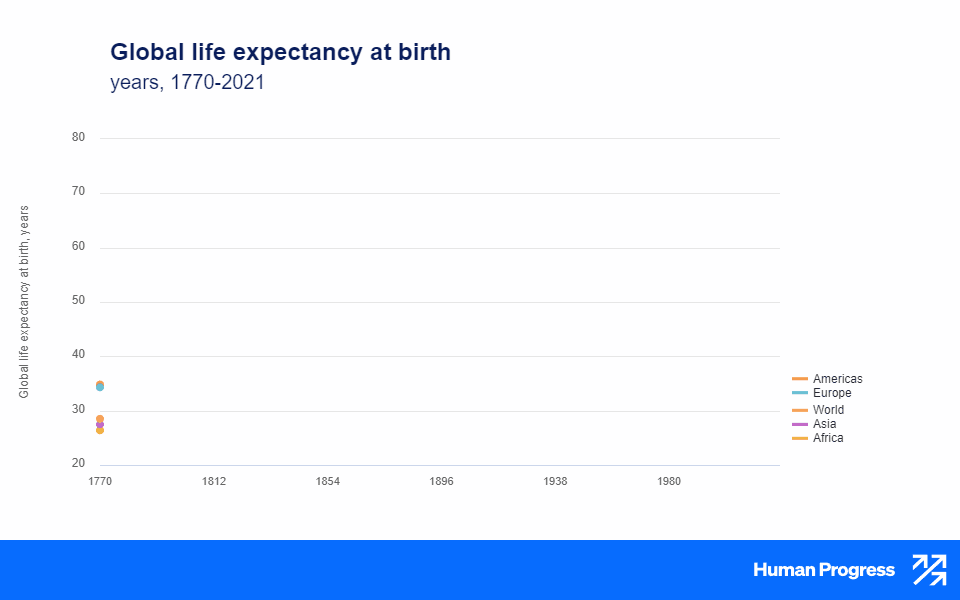Today marks the eighth installment in a series of articles by HumanProgress.org called Centers of Progress. Where does progress happen? The story of civilization is, in many ways, the story of the city. It is the city that has helped to create and define the modern world. This bi-weekly column will give a short overview of urban centers that were the sites of pivotal advances in culture, economics, politics, technology, etc.
Our eighth Center of Progress is Alexandria during the third and second centuries BC, when the Great Library marked the city as, arguably, the intellectual capital of the world. During the third century BC, an educational and research institution called the Musaeum (literally, “shrine of the Muses”), from which we get the word museum, was built in Alexandria. The Great Library of Alexandria was one part of the Musaeum. While estimates vary widely, the library may have held around 700,000 scrolls, the equivalent of more than 100,000 printed books. The amalgamation of so much written knowledge in one place represented a breakthrough in the way that humanity stored and distributed information.
For people today, who have grown up with unparalleled access to information thanks to the internet, it is difficult to comprehend a world where information is out of reach. But throughout much of history, knowledge often went unwritten. Even when written down, information was typically scattered in different places or otherwise inaccessible.
In the Great Library of Alexandria, much of humanity’s collective knowledge of subjects ranging from medicine to astronomy, could be accessed in a single place. Among the writings that you could browse in the library were histories, philosophical treatises, literary works of poetry and prose, and the Pinakes—believed to be the world’s first library catalog. Philosophers and scholars flocked to the city, attracted by its library’s vast compendium of information and the city’s reputation as an intellectual center.
Alexandria was founded in 331 BC, by the Macedonian leader Alexander the Great, who was in the midst of conquering the Persian Empire. Alexander drove out the Persian invaders who had deposed the last indigenous king of ancient Egypt just over a decade prior. Alexander departed from Egypt a few months after founding Alexandria, leaving his viceroy Cleomenes in charge.
After Alexander passed away in 323 BC, one of his deputies, a Macedonian general by the name of Ptolemy Lagides, took control of Egypt. Ptolemy executed Cleomenes and declared himself pharaoh. He started what came to be known as the Ptolemaic dynasty and made Alexandria his capital in 305 BC. The Ptolemy family, despite a seemingly hereditary tendency toward morbid obesity and lethargy, managed to stay in power until 30 BC.
The city’s population rapidly grew to around 300,000 people. Alexandria became a key center of Hellenistic civilization. It remained the capital of Ptolemaic Egypt, as well as Roman and Byzantine Egypt, for almost a millennium (until the Muslim conquest of Egypt overseen by the Rashidun Caliphate in 641 AD). Alexandria was also the largest city in the ancient world, until Rome eventually grew even larger.
Today, Alexandria is the second-largest city in Egypt. It is a major economic center and the most populous city on the Mediterranean Sea. It has a population of over 5 million people. Alexandria is thus also the sixth-largest city in the Arab world and the ninth-largest city in Africa. Due to its historical importance, it is a well-frequented tourist destination. It is also a major industrial center due to its pipelines of natural gas and oil from the Suez.
If you were to sail to Alexandria during the time of its famed library, you would have been struck by the towering sight of one of the Seven Wonders of the Ancient World. Hellenic Alexandria was home to one of the most impressive and famous sites in antiquity, the Pharos or the great lighthouse, which was constructed in the 3rd century BC. Standing at least 330 feet high (and possibly higher), the Pharos was taller than the Statue of Liberty (305 feet) and Rio’s iconic Christ the Redeemer statue (125 feet). For many centuries, the Pharos remained among the tallest man-made structures in the world. At the top of the lighthouse’s tower, a fire, which was likely kept burning with oil rather than wood, lit the way for ships that were entering Alexandria’s harbor.
Sailing nearer, you would have seen the city of Alexandria emerge on an isthmus opposite the small island on which the Pharos stood. You would have viewed the city’s classical architecture laid out among the orderly parallel lines of the city’s streets. Alexandria was designed by the architect Dinocrates of Rhodes, using a Hippodamian gridiron street plan. After docking at the harbor and setting foot in the city itself, you would have observed a wide variety of people, with the three most common ethnicities being Greeks, Jews, and Egyptian Arabs.
In other words, the city was cosmopolitan and diverse. In the city’s southwest was the Rhakotis—a settlement predating Alexandria that had been absorbed into the city. It was mainly inhabited by Arabs. Some of the city’s Arab residents may have continued to wear the Egyptian kilts, tunics and dresses that had been common before Alexander the Great’s conquest and Ptolemaic rule. However, many urban Arabs adopted the wearing of Hellenized clothing as a social marker of status. The Jewish quarter in the city’s northeast was home to one of the largest urban Jewish communities in the world at the time. During the city’s golden age, Alexandria was tolerant of religious differences. Notable Jewish Alexandrians included the historian Artapanus of Alexandria, Demetrius the Chronographer, and the playwright known as Ezekiel the Tragedian.
The Brucheum was the wealthy Greek or Royal quarter of Alexandria, and it was there that the city’s grandest architecture could be found. Most people there would have worn Greek garments such as the himation and chiton, or highly Hellenized versions of traditional Egyptian clothing. In the Brucheum you would have seen magnificent temples to the Greeks’ deities—prominently Poseidon, the god of the sea. Alexandria was, after all, a coastal city dependent on maritime trade. The Brucheum also contained a theater, and you could have seen theatergoers milling about it, discussing the latest plays. Alexandria had a thriving arts scene. The city was famous for its professional entertainers, “a combination of mime and dancer,” as well as its poets and playwrights.
Within the royal palace’s grounds in the Brucheum, you would have found the Musaeum and the Library—two beautifully decorated edifices in a campus of architecturally intricate buildings and flowering gardens. The Musaeum building included a lengthy roofed walkway and a large communal dining hall, where scholars dined and exchanged thoughts. The Musaeum also contained exhibit halls (from which we derive the modern sense of “museum”), private study rooms, lecture halls, residential quarters for scholars, and theaters for live performances. The Great Library consisted of shelves upon shelves of papyrus scrolls.
The Musaeum was most likely founded by the first Ptolemy king, Ptolemy Soter I, who is thought to have entrusted the creation of the Musaeum and the Great Library to Demetrius of Phaleron—a former Athenian politician, who had fallen from power in his home city-state, and sought refuge at Ptolemy’s court. A letter surviving from the 2nd century BC reveals that the new institution was envisioned as a universal library that would encompass all of the world’s written knowledge:
“Demetrius…had at his disposal a large budget in order to collect, if possible, all the books in the world…to the best of his ability, he carried out the king’s objective.”
The library soon compiled the whole corpus of Greek literature, including the “books of Aristotle,” along with various texts in other languages such as Egyptian. The Musaeum’s scholars produced many new works to add to the shelves.
The Musaeum was a research institution with over a thousand scholars living and working in the complex at any given time. The Museaum’s scholars were salaried employees, who were motivated, in part, by monetary incentives. On top of their salaries, for example, they received free room and board, and paid no taxes. Their expertise spanned a range of disciplines. One room in the Musaeum was dedicated to the study of anatomy; another area was dedicated to astronomy, and so on. A famous medical school was also established at the Musaeum, where Galen would study centuries later. Papyrus scrolls in the Great Library likely chronicled everything from mental disorders to intestinal diseases, from surgery and bone-setting to dentistry and even the making of false teeth.
It was thanks to the Great Library that the scholars of the Musaeum were able to achieve so much. The library marked Alexandria as the world capital of information, attracting many of the brightest minds of the day. In Alexandria, the astronomer Aristarchus (c. 310 BC-c. 230 BC) theorized that the earth revolves around the sun. He did so 1800 years before Copernicus. The physician Herophilus (325 BC-255 BC) first identified the brain as the organ that controls the movement of the body. The Egyptian priest Manetho (early 3rd century BC) chronicled Egypt’s pharaohs and organized Egyptian history into dynasties still used by historians today. The poet Callimachus (c. 305 BC-c. 240 BC) detailed the texts in the library, which were organized by subject and author, thus creating the first library catalog and becoming the father of library science.
The inventor and mathematician Archimedes (287 BC-212 BC) studied in Alexandria and may also have taught there. While taking a bath, Archimedes realized that displaced water could be used to measure the volume of an object. He is said to have shouted Eureka! (Greek for “I have found it!”), leapt from a bathtub without bothering to dress, and ran through the streets to announce his discovery. The geographer Eratosthenes (c. 276 BC-194 BC) also taught in Alexandria and made his groundbreaking calculation of the circumference of the Earth in that city. He was the founder of chronology, the first person to calculate the tilt of the Earth’s axis, and the creator of the first global map projection of the world (In cartography, a map projection is a precise method of displaying the globe’s surface as a flat plane while maintaining accuracy). The founder of the mathematical sub-discipline of geometry, Euclid (born c. 300 BC) taught at Alexandria too. Later, the engineer and mathematician Hero (also called Heron, 10 AD-70 AD), nicknamed “the greatest experimenter of antiquity,” lived and worked in Alexandria as well. It was there that he invented the aeolipile — the first known device to transform steam into rotary motion. (At the time, the steam turbine was treated as an amusing curiosity without any practical purpose).
The Great Library and the Musaeum were open to scholars from all cultures and backgrounds. A few centuries after the period that concerns us, one of the first recorded female scholars, the philosopher and mathematician Hypatia (born between 350 and 370 AD and died 415 AD) would work in Alexandria, in the spirit of the Musaeum even after that institution’s destruction. Both women and men were allowed to study the texts in the Great Library.
While other cities had built libraries before, Alexandria pioneered the idea of a universal library at a scale never before achieved. Libraries and archives were kept in many cities in various ancient civilizations, including Egypt, Mesopotamia, Syria and Greece. However, those earlier institutions were limited in scope, typically only contained local knowledge or covered a particular subject area, and were chiefly oriented toward conservation of a particular cultural tradition or heritage.
The idea of a universal library, like that of Alexandria, proved game-changing. Alexandria’s library contained works concerning practices from far away. To give an example, it included scrolls describing Buddhism, which arrived in the library as a result of diplomatic exchange between India’s Ashoka and Ptolemy II Philadelphus. Alexandria inspired other cities to create rival “universal libraries,” such as the Library of Pergamum in what is today Turkey.
The Great Library was eventually destroyed. The main library structure was likely burned in 48 BC, when the last Ptolemy ruler, Ptolemy XIII, laid a siege against his wife, sister and co-ruler Cleopatra and her lover, the Roman dictator Julius Caesar. The secondary library building, in the Serapeum temple, which was added when the first library could fit no more scrolls, may have survived until the 4th century, when the Byzantine Emperor Theodosius I ordered the demolition of all pagan temples.

For seeking to compile all of the known knowledge in the world in one place and make it accessible to scholars from all parts of the Mediterranean, Alexandria during the third and second centuries BC is deservedly our eighth Center of Progress. Alexandria pioneered the concept of a universal library. Long after the Great Library of Alexandria ceased operating, people have continued to expand the store of human knowledge, and access to it, ultimately culminating in tools like Google and Wikipedia. Today, many of us carry the keys to a library that is infinitely larger than Alexandria’s—in our pockets in the form of smartphones.






